Prostatitis in Men: Causes, Symptoms, Diagnosis & Treatment

TABLE OF CONTENTS
Prostatitis is one of the most common urinary tract conditions affecting men. This condition affects the prostate, a walnut-shaped gland that produces fluid for semen as part of the male reproductive system. The condition appears in four distinct types, ranging from acute bacterial prostatitis, which requires emergency medical attention, to chronic pelvic pain syndrome, which affects approximately one in three men. While the exact reason remains unclear in some cases, prostatitis can stem from bacterial infections, immune system responses, or nerve damage.
This comprehensive guide explains what men need to know about prostatitis, including its symptoms, causes, diagnosis methods, and treatment options. Readers will also learn about prevention strategies and effective ways to manage this condition.
Symptoms
The hallmark of prostatitis is pain felt deep in the pelvis, particularly in the area between the scrotum and anus (perineum). This discomfort can manifest alongside various urinary and sexual symptoms depending on which type of prostatitis affects the patient.
Men with prostatitis commonly experience:
Pain in the lower abdomen, genitals, perineum, or lower back
Frequent and urgent need to urinate
Painful or difficult urination (dysuria)
Interrupted urine stream that stops and starts
Blood in urine (hematuria) or semen (hematospermia)
Pain during sexual intercourse (dyspareunia)
Painful ejaculation
Erectile difficulties
Prostatitis symptoms vary significantly based on the type. For instance, acute bacterial prostatitis presents with distinct flu-like symptoms like fever, body aches, and chills, which aren't typically found in other forms. On the other hand, some men with nonbacterial prostatitis might not display any symptoms.
Although prostatitis typically involves inflammation of the prostate, pelvic pain might stem from other sources. These include pelvic muscle tightness, prostate or bladder stones, urethral stricture (narrowing of the tube that drains the bladder), or serious conditions like prostate or bladder cancer.
Causes
The causes of prostatitis differ according to the specific type.
Bacterial prostatitis occurs when bacteria invade the prostate through the urethra or when urine flows backwards into the prostate (vesicoureteral reflux). Several factors can trigger bacterial forms, such as bladder infections, sexually transmitted infections, urinary tract infections, pelvic injuries, or procedures involving the urinary tract like catheterisation or prostate biopsies.
Chronic nonbacterial prostatitis, however, isn't caused by bacterial infection despite producing similar symptoms. Potential contributors to this form include autoimmune diseases, pelvic floor muscle damage, nerve irritation, stress, past bacterial infections, or irritation from chemicals.
Furthermore, certain activities can increase the risk of developing nonbacterial prostatitis, including bicycle riding, which places pressure on the perineum area. Other possible causes involve parasites, viruses, or pelvic floor muscle problems. Life stresses and emotional factors may also significantly affect this condition.
Men over 50 are at increased risk for all types of prostatitis, especially those with enlarged prostates (benign prostatic hyperplasia). A history of recurrent UTIs, urinary tract abnormalities, catheter use, or previous instances of prostatitis can likewise elevate the risk of developing bacterial prostatitis.
Chronic prostatitis often involves chemical inflammation rather than a bacterial infection. This occurs when stale urine shoots into the prostate due to turbulent flow, particularly in men with tight bladder neck muscles that cause poor bladder emptying. The pool of stale urine in the bladder can harbour bacteria, potentially leading to bacterial prostatitis when contaminated urine enters the prostate.
Diagnosis and Tests
Diagnosing prostatitis requires several tests and examinations, as the condition shares symptoms with other urinary and reproductive system issues. Doctors often begin with a thorough evaluation of symptoms and medical history before recommending specific diagnostic procedures.
Physical Examination and Basic Tests
The diagnostic process typically starts with a digital rectal exam (DRE). During this exam, the doctor inserts a gloved, lubricated finger into the rectum to check for prostate inflammation, pain, or abnormalities. This basic examination helps directly assess the condition of the prostate gland.
Laboratory Tests
Urine tests: These check for infection and identify the specific type of bacteria present
Blood tests: These may reveal signs of infection or other prostate conditions
Prostatic specimen test: Sometimes, the doctor gently massages the prostate during the rectal exam to release prostatic fluid into the urethra for testing
Advanced Diagnostic Procedures
If initial tests show no clear evidence of infection, yet symptoms persist, the doctor might recommend additional testing:
Urodynamic tests: These measure bladder and urethra function, including how well they hold and release urine
Imaging tests: Transrectal ultrasound or other imaging can reveal abnormalities in the prostate gland, including abscesses or stones
Cystoscopy: This procedure allows doctors to view the inside of the bladder & urethra using a thin tube with a camera, though it doesn't directly diagnose prostatitis
PSA Testing Considerations
The prostate-specific antigen (PSA) test measures levels of a protein produced by the prostate gland. While primarily used for prostate cancer screening, PSA levels can also elevate in non-cancerous conditions as well, including prostatitis. Consequently, doctors often avoid obtaining PSA levels during acute bacterial prostatitis, as they can be misleadingly high.
Management and Treatment
Treatment options for prostatitis vary based on the specific type and underlying cause. Doctors typically tailor treatment plans to individual patients after thorough assessment and diagnosis.
Medications:
Antibiotics remain the cornerstone treatment for bacterial forms of prostatitis. For acute bacterial prostatitis, patients often receive 14 to 30 days of antibiotics, sometimes administered intravenously in hospital settings. Chronic bacterial prostatitis requires a longer course, typically ranging from 4 to 12 weeks.
Alpha-blockers are vital in managing urinary symptoms by relaxing smooth muscles in the neck of the bladder and prostate. Medications like tamsulosin, alfuzosin, terazosin, and doxazosin facilitate urinary flow and relieve obstruction caused by prostate inflammation. These medications are particularly helpful for men with chronic prostatitis/chronic pelvic pain syndrome.
Pain management: Options include:
Nonsteroidal anti-inflammatory drugs (NSAIDs) like ibuprofen
Prescription pain medications such as amitriptyline or gabapentin for neurogenic pain
Hot sitz baths to relieve discomfort
Pelvic floor physical therapy for muscle spasm relief
For chronic pelvic pain syndrome, many specialists utilise the UPOINT system, which addresses six symptom categories simultaneously. This multimodal approach shows improvement in most patients. Beyond conventional medications, some evidence supports the use of phytotherapy, such as quercetin and bee pollen supplements, to reduce prostate inflammation.
At-home management strategies: These include staying well-hydrated, avoiding irritants like spicy foods, caffeine and alcohol, and using donut-shaped pillows when sitting. Some men benefit from stress management techniques or counselling, as psychological factors often influence chronic pain conditions.
Surgery is rarely needed for prostatitis unless an abscess requires drainage. Most cases improve with medical management and supportive care. For patients who don't respond to conventional therapies, referral to pain management specialists might be appropriate.
Prevention
While researchers continue to study what exactly causes prostatitis, several practical steps can reduce your risk of developing this condition. Prevention strategies range from simple lifestyle changes to proper medical care, including:
Prompt treatment of urinary tract infections (UTIs) stands as one of the most effective ways to prevent bacterial prostatitis. By addressing UTIs quickly, you can stop the infection from spreading to your prostate gland.
Safe sexual practices remain equally important. Using condoms consistently during every sexual encounter helps prevent sexually transmitted infections that could potentially lead to prostatitis. This precaution becomes even more crucial if you have multiple sexual partners.
Good hygiene practices further support prostate health. Keeping the genital area clean helps prevent infections that might affect the prostate.
Staying physically active offers substantial benefits. Men who exercise at least three times weekly report fewer prostatitis symptoms. Brisk walking, stretching, or joining cardio classes at the gym all contribute positively to prostate health.
Dietary choices play a substantial role in maintaining a healthy prostate:
Eat plenty of fruits & vegetables rich in nutrients
Choose whole grains over refined carbohydrates
Limit red meat consumption
Select healthy fats from sources like olive oil, nuts and avocados
Avoid spicy foods that may irritate the bladder
Reduce caffeine and alcohol intake
Maintaining proper hydration deserves special attention. Drinking sufficient water keeps your urine diluted and helps flush your bladder regularly, reducing bacterial growth.
Limiting prolonged sitting, especially on hard surfaces like bicycle seats, reduces pressure on your prostate gland.
Stress management approaches, including meditation and relaxation exercises, can help prevent some forms of prostatitis, as stress has been linked to increased symptoms.
Maintaining a healthy weight through proper diet and regular exercise supports overall prostate health and reduces your risk of developing various prostate problems, including prostatitis.
Being vigilant about your health represents another crucial prevention strategy. See your doctor promptly if you notice changes in urination patterns or experience pain in your pelvic area. Early intervention often prevents minor issues from developing into more serious prostate conditions.
Outlook / Prognosis
The recovery outlook for men with prostatitis generally depends on which type they have—men who receive prompt treatment for acute bacterial prostatitis experience full recovery. Most cases of acute bacterial prostatitis are cured with appropriate antibiotic treatment. This form resolves with medication and minor adjustments to diet and behaviour, though patients should be aware that it occasionally returns or develops into chronic prostatitis.
Research reveals that bacterial prostatitis has a higher relapse rate. Several factors influence the likelihood of relapse or progression to chronic prostatitis:
Diabetes mellitus
Benign prostatic hyperplasia (enlarged prostate)
Urinary incontinence
History of previous urinary tract infections
Inadequate antibiotic therapy
For chronic prostatitis, the outlook becomes more complex. Although challenging to treat, most people with chronic pelvic pain syndrome (CPPS) experience improvement after receiving symptom-focused treatment using the UPOINT system.
Throughout the recovery process, it's essential for patients to maintain consistent communication with their doctors. As pointed out by medical experts, it's not normal to experience pain in the rectum and genital areas or changes in urination patterns. These symptoms warrant medical attention.
Generally, with appropriate treatment and management strategies, most men with prostatitis can expect improvement in their condition and quality of life. Regular follow-up appointments help address any persistent symptoms promptly to prevent complications or chronic development.
Living With Prostatitis
Men with prostatitis often face significant challenges in their day-to-day lives. Studies reveal that chronic prostatitis substantially impairs health-related quality of life and has a noticeable impact on both physical and mental health.
Daily physical activity plays a crucial role in managing prostatitis. The study found that more physically active men experienced fewer symptoms of benign prostatic hyperplasia. Even moderate activities like regular walking at a moderate pace yielded notable benefits.
Diet modifications represent another essential aspect of living with prostatitis:
Foods to include: Tomatoes (rich in lycopene), cruciferous vegetables (containing sulforaphane), citrus fruits (high in vitamin C), nuts (zinc-rich), fish (omega-3 fatty acids), and berries (antioxidants)
Foods to avoid: Dairy products, red meat, alcohol, high-sodium foods, and caffeine-containing items like coffee, tea and chocolate
Support groups provide invaluable assistance for prostatitis patients. These groups create safe spaces where men can openly discuss their experiences, concerns, and recovery strategies.
Home remedies that may help manage symptoms include warm baths (sitz baths), heating pads applied to the perineum, and drinking plenty of water. Some alternative treatments showing promise include biofeedback, acupuncture, and certain herbal remedies like rye grass pollen extract.
Immediately contact your doctor if you experience blood in urine or semen, difficulty urinating, pain during urination, painful erections, or pain during sexual activity.
Conclusion
Prostatitis affects millions of men worldwide, yet each case requires unique attention and treatment. Though acute bacterial prostatitis responds well to antibiotics, chronic forms need comprehensive management strategies. Most men achieve significant symptom relief through appropriate medical care combined with lifestyle changes.
Success rates vary based on the type of prostatitis and the chosen treatment approach. Men who follow their prescribed treatment plan, make recommended dietary changes, and stay physically active often experience better outcomes. Regular communication with doctors remains essential throughout the recovery journey.
FAQs
How long does it typically take for prostatitis symptoms to improve after starting treatment?
Most men experience symptom relief within two weeks of starting treatment, particularly with antibiotics for bacterial prostatitis. However, complete resolution of all symptoms may take several weeks.
What are the potential risks of leaving prostatitis untreated?
Untreated prostatitis can lead to serious complications, including blood infections (sepsis), testicular infections, prostate abscesses, and in some cases, fertility issues. It's crucial to seek medical attention if you experience prostatitis symptoms.
What does a comprehensive treatment plan for prostatitis usually involve?
Treatment typically includes antibiotics for bacterial prostatitis, pain management medications, alpha-blockers to improve urinary symptoms and lifestyle modifications. In some cases, doctors recommend physical therapy or stress management techniques.
How effective are treatments for prostatitis?
Treatment effectiveness varies and depends on the type of prostatitis. Acute bacterial prostatitis often responds well to antibiotics, while chronic forms may require more complex, long-term management strategies.
Can lifestyle changes help manage prostatitis symptoms?
Yes, lifestyle modifications can significantly help manage symptoms. These may include regular exercise, avoiding irritants like alcohol and spicy foods, staying hydrated, and using cushions when sitting for long periods. A healthy diet enriched in fruits, vegetables, and whole grains can also support prostate health.






